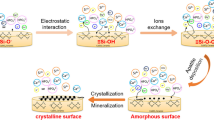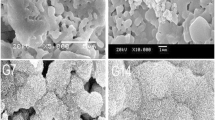Abstract
Alpha-tricalcium phosphate (α-TCP) ceramic is a bioresorbable material that degrades in bone tissue after implantation, since it exhibits higher solubility than beta-tricalcium phosphate (β-TCP) ceramics. The high solubility of α-TCP in an aqueous solution causes its transformation into hydroxyapatite (HAp) through hydrolysis. While one expects the formation of hydroxyapatite after exposure to an aqueous solution mimicking a body environment, we occasionally find variation in HAp formation in the simulated body fluid (SBF). In the present study, HAp formation resulting from exposure to SBF was investigated for some types of α-TCP ceramics with different porosities and specific surface area. Reduced porosity and large surface area of porous specimens may increase the local density of Ca2+ in the surrounding SBF to increase the degree of supersaturation with respect to HAp. Thus, the porosity and specific surface area are significant parameters for determining not only bioabsorbability but also the ability to form HAp.





Similar content being viewed by others
References
Rejda BV, Peelen JG, DE KGroot. Tri-calcium phosphate as a bone substitute. J Bioeng. 1977;1:93–7.
Metsger DS, Driskell TD, Paulsrud JR. Tricalcium phosphate ceramic—a resorbable bone implant: review and current status. J Am Dent Assoc. 1982;105:1035–8.
Fujishiro Y, Takahashi K, Sato T. Preparation and compressive strength of alpha-tricalcium phosphate/gelatin gel composite cement. J Biomed Mater Res. 2001;54:525–30.
Yuan H, Bruijin JDDE, Li Y, Feng J, Yang Z, Groot KDE, et al. Bone formation induced by calcium phosphate ceramics in soft tissue of dogs: a comparative study between porous α-TCP and β-TCP. J Mater Sci: Mater Med. 2001;12:7–13.
Kitamura M, Ohtsuki C, Ogata S, Kamitakahara M, Tanihara M. Microstructure and bioresorbable properties of α-TCP ceramic porous body fabricated by direct casting method. Mater Trans. 2004;45:983–8.
Kitamura M, Ohtsuki C, Iwasaki H, Ogata S, Tanihara M, Miyazaki T. The controlled resorption of porous α-tricalcium phosphate using a hydroxypropylcellulose coating. J Mater Sci: Mater Med. 2004;15:1153–8.
Kokubo T, Kushitani H, Sakka S, Kitsugi T, Yamamuro T. Solutions able to reproduce in vivo surface-structure changes in bioactive glass-ceramic A-W. J Biomed Mater Res. 1990;24:721–34.
Cho SB, Nakanishi K, Kokubo T, Soga N, Ohtsuki C, Nakamura T, et al. Dependence of apatite formation on silica gel on its structure: effect of heat treatment. J Am Ceram Soc. 1995;78:1769–74.
Ohtsuki C, Aoki Y, Kokubo T, Bando Y, Neo M, Nakmura T. Transmission electron microscopic observation of glass-ceramic A-W and apatite layer formed on its surface in a simulated body fluid. J Ceram Soc Jpn. 1995;103:449–54.
Kokubo T, Takadama H. How useful is SBF in predicting in vivo bone bioactivity? Biomaterials. 2006;27:2907–15.
Uchino T, Ohtsuki C, Kamitakahara M, Tanihara M, Miyazaki T. Apatite formation behavior on tricalcium phosphate (TCP) porous body in a simulated body fluid. Key Eng Mater. 2006;309–311:251–4.
Elliot JC. Structure and chemistry of the apatites and other calcium orthophosphates. Amsterdam: Elsevier; 1994. p. 34.
Ohtsuki C, Tanihara M, Miyazaki T, Ogata S. Hand book of organic-inorganic hybrid materials and nanocomposites. Valencia, CA: American Scientific Publishers; 2003. p. 265–93.
Author information
Authors and Affiliations
Corresponding author
Rights and permissions
About this article
Cite this article
Uchino, T., Yamaguchi, K., Suzuki, I. et al. Hydroxyapatite formation on porous ceramics of alpha-tricalcium phosphate in a simulated body fluid. J Mater Sci: Mater Med 21, 1921–1926 (2010). https://doi.org/10.1007/s10856-010-4042-4
Received:
Accepted:
Published:
Issue Date:
DOI: https://doi.org/10.1007/s10856-010-4042-4




